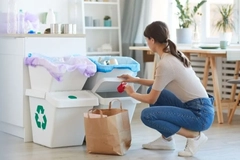Self healing plastic: German scientists develop biodegradable mineral biopolymer that regenerates after damage
31 Jul 2023 --- Scientists at the University of Konstanz, Germany, have developed bio-based and biodegradable next-generation mineral plastics. Created using a natural biopolymer – polyglutamic acid (PGlu) – the material was found to completely degrade after 32 days.
First developed in 2016, the mineral plastics’ shortcoming was difficulty in biodegrading. “Previously, we used polyacrylic acid to produce our mineral plastic. Chemically, this acid has the same backbone as PE, which is known to cause major problems in the environment because it is hardly biodegradable,” shares project lead Helmut Cölfen.
“Our new mineral plastic has the same positive properties as the previous one but has the decisive advantage that its basic building block – polyglutamic acid – can be produced with the help of microorganisms and is completely biodegradable.”
The Konstanz team mixed PGlu, calcium chloride and alcohol in water to form an environmentally safe alternative to conventional plastics. The mineral plastic is described as “stretchable, deformable and reversibly swellable.” Additionally, in their study published in the journal Small Methods, the team states that the mineral plastic exhibits self-healing properties.
“Imagine having your phone’s protective film scratched. If it was made of mineral plastic, you could just drip a little water on the scratch, then the plastic in that spot would turn into self-healing hydrogel, and the scratch would disappear on its own. Once it dries, you would have an undamaged protective film again,” Cölfen had previously explained. .jpg) Scanning electron microscope image of the new mineral plastic.
Scanning electron microscope image of the new mineral plastic.
Biodegradability
The research team led by Cölfen and Ilesha Avasthi, a postdoctoral researcher in Cölfen’s lab, were looking for an alternative basic building block to develop an environmentally compatible mineral plastic that retains the intriguing properties of the original material.
They found the solution in PGlu, which is readily available in large quantities and can be obtained through biotechnological production using microorganisms. Moreover, the scientists state that various microorganisms in the environment can degrade the material.
“The biodegradability of PGlu-based mineral plastics, as confirmed in this study, makes it a very attractive polymer to be used for the development of environmentally safe materials,” they write.
“The elements [nitrogen, calcium and iron] present in the PGlu-based mineral plastics act as additional nutrients, supporting the growth of microorganisms and consequently, promoting the degradation process.”  Schematic image of the interactions in mineral plastic. The curved black line corresponds to the polyglutamic acid backbone of the mineral plastic.
Schematic image of the interactions in mineral plastic. The curved black line corresponds to the polyglutamic acid backbone of the mineral plastic.
Packaging applications
The Konstanz chemists detail that easy tunability makes PGlu-based mineral plastics a “highly interesting” class of materials with numerous potential applications.
“They can effectively be used as adhesives, cell phone screen covers, non-flammable, insulating foams as opposed to styrofoams, parts in hot environments like in ovens and motors, since they are non-flammable.”
“Hence, the PGlu mineral plastics can be efficiently tailored for a number of applications with the valuable advantage of being biodegradable. Further, it also helps us ensure a rational, [environmentally] sustainable and eco-friendly approach to developing plastic alternatives.”
Edited by Radhika Sikaria






_0.png)





